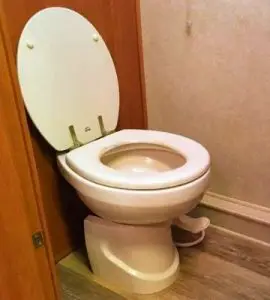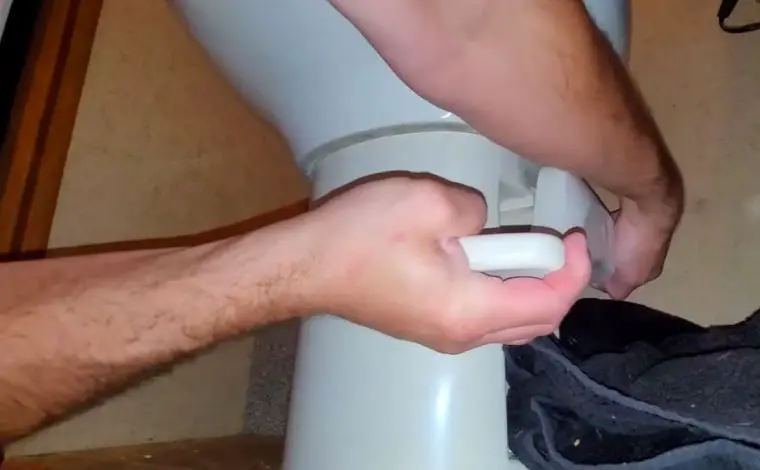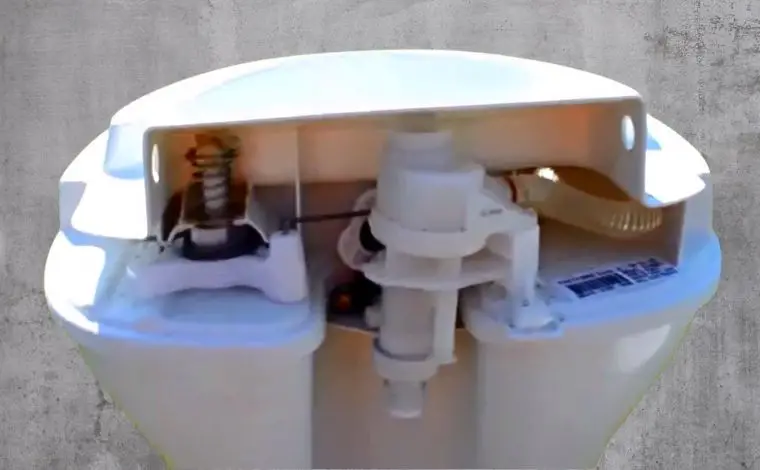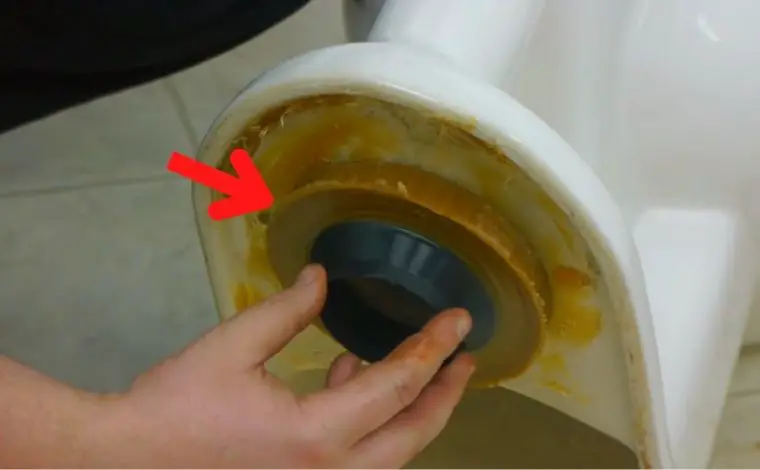If you love road trips, nature, and the freedom of traveling wherever your heart desires, your RV or camper is probably your second home. But nothing ruins that freedom faster than a foul sewage smell sneaking up from your camper toilet. Imagine this — you’re parked in a beautiful forest, sipping your morning coffee, when suddenly your RV smells like a rotten egg factory. Not exactly the kind of fresh air you were hoping for, right?
The good news is, this unpleasant smell has clear causes and simple fixes. In this article, you’ll learn why your camper toilet smells like sewage, how the system actually works, and the best ways to get rid of that nasty odor permanently.
Related Article: Why does my toilet smell like urine?
What Is a Camper or RV Toilet?
 A camper or RV toilet isn’t the same as your home toilet. While both are designed to handle human waste, RV toilets are compact, portable, and connected to a black water holding tank instead of a fixed sewage line.
A camper or RV toilet isn’t the same as your home toilet. While both are designed to handle human waste, RV toilets are compact, portable, and connected to a black water holding tank instead of a fixed sewage line.
These toilets are specifically built for mobility — whether you’re camping in the woods, traveling cross-country, or boondocking in the desert. However, because the entire waste system is enclosed inside your RV, poor maintenance or small leaks can quickly cause foul smells to spread through your living area.
Key Differences from a Regular Toilet
-
No fixed plumbing system: Instead of underground sewage pipes, waste goes into a portable black tank.
-
Manual or pedal flushing: RV toilets often use a foot pedal or lever to flush.
-
Limited water use: To conserve water, RV flushes use less water, which can allow waste buildup if not managed.
-
Portable waste tank: The black tank needs to be emptied manually at a dump station.
In short, while RV toilets make your travel life easier, they demand extra care and maintenance to keep things clean and odor-free.
How Does a Camper or RV Toilet Work?
Understanding how your RV toilet system works helps you pinpoint where odors come from.
An RV toilet operates through a simple but delicate system of valves, tanks, and seals.
-
The Flush Mechanism:
Most RV toilets use a foot pedal or lever to open a valve and allow water into the bowl. When flushed, the waste and water flow directly into the black tank underneath. -
The Black Tank:
This tank holds all solid and liquid waste. Because it’s sealed and stored beneath your RV, it’s crucial to empty it regularly to prevent overflow or gas buildup. -
Seals and Valves:
A rubber seal or ball valve keeps odors trapped inside the tank. If it becomes dry or damaged, gases can escape easily. -
Vent Pipe:
The vent pipe lets sewer gases escape through the roof. When it’s blocked, those gases have nowhere to go — except back inside your RV.
Essentially, it’s a miniature sewage system on wheels, and when any part of it malfunctions, odors become inevitable.
Why Does My Camper Toilet Smell Like Sewage?
If your RV toilet smells like a sewer or rotten eggs, there are several possible culprits. Let’s look at the most common ones.
1. Leakage in the System
Leaks are among the top reasons for sewer odors. If the connections between your toilet, flange, or black tank are loose or cracked, gases can escape into your camper.
-
Back of the Toilet: Check the water supply line and the valve. If it’s loose, tighten it. If leaking persists, replace the valve.
-
Vacuum Breaker Leak: Some toilets have a vacuum breaker that can fail during flushing. Replacing it usually fixes the issue.
-
Flange Seal Issues: The seal between the toilet and the flange can wear out. Remove the toilet, inspect the flange height, and use spacers or a new seal if needed.
2. Toilet Can’t Hold Water
Your toilet bowl should always hold a bit of water to block sewer gases. If it drains away quickly, you may have debris in the blade or ball seal.
Clean the seal area, and if it’s cracked or worn, replace it immediately. A dry seal is like an open door for sewage gases.
3. Poor Flushing Mechanism
A weak flush can leave waste residue inside the black tank or bowl.
Make sure the foot pedal or lever is fully pressed when flushing. If the flush feels sluggish, check your water line and fill valve for buildup or rust. Use RV-safe toilet chemicals to break down waste more effectively.
4. Seepage from the Black Tank
Over time, small leaks or cracks in your black tank can release gases. Even when driving, the sloshing inside can force odors through small openings.
If you suspect leakage, inspect the tank and seals closely. You may need to apply a special RV tank sealant or replace the tank if the damage is severe.
5. Bad Connections from Other Plumbing Fixtures
Your RV’s sink, shower, and gray water tank can also cause odors. If you notice a foul smell near these areas, the problem might be a dry P-trap or loose connection. Fill the traps with water or check for leaks in the hoses and vents.
How to Get Rid of the Bad Sewage Smell from Your Camper Toilet
Now that you know the causes, here’s how to eliminate the odor and keep your RV fresh.
1. Replace the Damaged Wax or Rubber Ring
If you smell sewage near the toilet base, a broken wax ring (or rubber seal) might be the cause.
Steps:
-
Turn off the RV’s water supply.
-
Flush the toilet to empty the bowl.
-
Remove moisture with a sponge.
-
Unscrew and lift the toilet carefully.
-
Clean the flange area thoroughly.
-
Replace the old ring with a new, high-quality seal.
-
Reinstall and tighten securely.
-
Turn the water back on and test for leaks.
This simple replacement can drastically reduce odors by sealing off sewer gases.
2. Unclog the RV Toilet and Shower Drain
Clogs are another common cause of foul smells. Waste or paper buildup can block the lines, causing gases to rise.
How to unclog safely:
-
Pour hot (not boiling) water and an RV-safe digester into the toilet bowl.
-
Let it sit for a few hours, then flush.
-
For the shower drain, pour a mix of baking soda and vinegar, wait 15 minutes, then rinse with warm water.
-
Check your gray water tank — if it’s full, empty it to allow proper drainage.
Avoid using harsh chemicals like bleach or drain cleaners, which can damage seals or pipes.
3. Clean the Black Water Tank Regularly
The black tank is the heart of your RV’s sewage system, and neglecting it guarantees bad smells.
Here’s the proper way to clean it:
-
Add a few gallons of clean water to the tank before use — never leave it dry.
-
Use enzyme-based RV tank cleaners after every dump to dissolve waste.
-
Every few weeks, deep clean the tank:
-
Mix 2 cups of bleach with pine cleaner and pour it in.
-
Let it sit for 15–20 minutes.
-
Flush and rinse thoroughly with clean water.
-
-
Always use RV-safe toilet paper that dissolves quickly.
Regular cleaning prevents buildup and bacterial growth that cause strong sulfur-like odors.
4. Empty the Black Tank Correctly
If you wait too long to empty your black tank, it can overflow, leak, or emit terrible odors.
Proper dumping process:
-
Park close to a certified dump station.
-
Wear disposable gloves for hygiene.
-
Attach the sewer hose tightly to both the dump valve and station inlet.
-
Open the black tank valve first — this lets solid waste exit.
-
After it empties, open the gray tank valve to flush out any residue.
-
Rinse the black tank using a flushing hose.
-
Add several gallons of water and tank treatment before using again.
Never use your freshwater hose for dumping waste — always keep it separate.
5. Check the Vent Pipe for Blockages
Your RV vent pipe allows gases to escape through the roof. When it’s blocked by debris, insects, or bird nests, the smell will back up inside the RV.
Climb onto the roof, remove the vent cap, and check for obstructions. Use a long brush or compressed air to clear it. Installing a 360-degree vent cap helps gases escape more efficiently.
6. Keep the Toilet Bowl Moist
RV toilet seals can dry out quickly, allowing smells to seep through. Always leave a small amount of clean water in the bowl after each use.
Adding a few drops of mineral oil or RV seal lubricant helps keep the gasket soft and airtight.
7. Use Enzyme-Based Treatments
Instead of chemical deodorizers, use enzyme treatments that naturally break down waste and toilet paper inside the tank.
These not only eliminate odors but also improve drainage and extend the life of your system.
Popular options include:
-
Happy Campers Organic RV Treatment
-
Thetford Aqua-Kem
-
Camco TST Max Enzyme Formula
Add them after every tank dump for best results.
8. Regularly Clean the Toilet Bowl and Exterior
Even if the smell comes from the tank, a dirty toilet bowl can make things worse.
Use non-abrasive RV toilet cleaners or a baking soda + vinegar solution. Gently scrub with a soft brush and rinse well. For the exterior, wipe with disinfecting wipes to prevent bacterial growth.
How to Maintain an RV or Camper Toilet Long-Term
Owning an RV means committing to regular maintenance. Here’s how to keep your system odor-free for the long haul:
-
Clean the black tank every 1–2 weeks, even if you don’t travel often.
-
Use plenty of water during flushing — too little water allows solids to stick.
-
Never use household toilet paper. Always buy RV-rated paper that dissolves quickly.
-
Check vent pipes and seals monthly to prevent gas leakage.
-
Use enzyme or bacterial treatments regularly to maintain balance in the tank.
-
Avoid parking under direct sunlight for long periods; heat intensifies odors.
-
Turn on the bathroom exhaust fan or open windows after every use.
-
Use a small bowl of baking soda or an RV air freshener to absorb smells.
Following these steps ensures your camper toilet stays as fresh as your travel destinations.
Common Mistakes RV Owners Make
Many beginners unintentionally worsen RV toilet smells through poor habits. Avoid these common mistakes:
-
Leaving the black tank valve open: It may seem convenient, but it causes liquid to drain while solids build up, creating a pyramid of waste.
-
Using bleach too often: While bleach kills bacteria, it can also damage rubber seals and sensors. Use it sparingly.
-
Neglecting the gray tank: Smells from sinks or showers can mix with toilet odors. Clean both tanks together.
-
Forgetting to lubricate seals: Dry seals lose their tight fit, allowing gases to escape.
-
Skipping freshwater flushes: After emptying, always add a few gallons of clean water to the black tank before reuse.
Final Words
A foul-smelling camper toilet can quickly turn a dream road trip into a nightmare. But the good news is, the solution is simple — regular maintenance, proper cleaning, and timely tank management.
Always remember:
Your RV toilet is a mobile sewage system, not a home one. It needs consistent attention to function properly. Keep your seals soft, tanks clean, and vents clear. The fresher your black tank, the fresher your entire RV will smell.
By following the tips shared in this article, you can say goodbye to sewage odors and enjoy your travels without the unpleasant “rotten egg” surprise.
So next time you hit the open road, you’ll breathe in crisp mountain air — not the fumes from your camper toilet.
Hi, this is Robert Crossan, the owner of this website, has 17 years of experience in the installation, maintenance, and repair of toilets and plumbing systems. After completing the Level 2 Basic Plumbing course in 2005, I started working in both domestic and commercial buildings as a professional plumber. So I can figure out the core difference between different toilet models and brands. It also helped me monitor their work performance and setbacks.